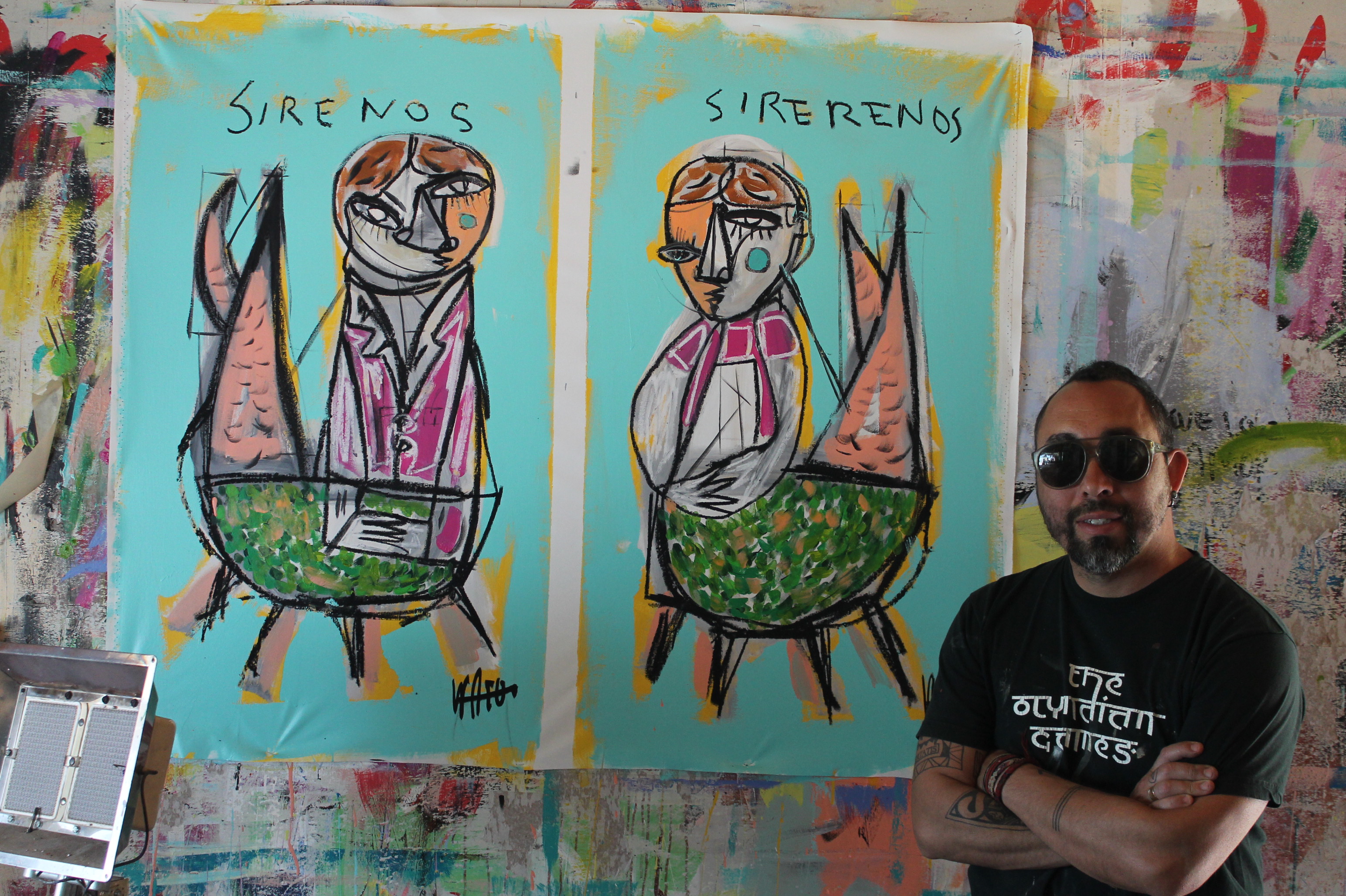
By Hope Yancey
Artist Nico Amortegui creates murals, other large-scale paintings and sculptures constructed of wood, cardboard and found objects.
He has recently begun learning to make ceramics, such as dishes and African-inspired masks. He might produce 30 ceramic pieces in a week. In a good week, he might make two or three paintings.
Amortegui is working on ceramics at Clayworks, a local organization that offers classes, programs and events.
He received word earlier this year that he had been awarded a 2019 Creative Renewal Fellowship from the Arts and Science Council, to immerse himself in the techniques of indigenous people in Oaxaca, Mexico, who make textiles and ceramics using traditional methods. “I was in shock when I got it. I’m still in shock,” he says. The award is intended to allow him to spend 10 days studying the craft.
“I’m pretty sure I cried at one point,” Amortegui recalls, remembering the phone call from the ASC.
Amortegui, 41, is a native of Colombia, and came to the United States as a teenager. While clay is new to him, he does have a familial connection from having helped his mother sell wares on the streets of Bogota, the capital city of Colombia.
He hails from a family of artists and creators, including an uncle in Colombia, Pablo Zapata, who has painted for at least 35 years.
On this morning, Amortegui is working in the eclectic, paint-spattered studio behind his house in a neighborhood not far from the intersection of Eastway and Shamrock drives. Zapata, 53, is in town for a spring visit and works outside on two paintings of his own.
Family is a vital influence on Amortegui’s creativity: His wife, Laine, assists with grant applications and in other ways. “We’re like a team. Basically, I just create the work, and she just makes sense out of what I try to say,” he notes.
Daughters Lucca, 9, and Petra, 6, often are in his thoughts, and he thinks about how they will view his art. He describes them as transporting him “back into a childhood state of mind.” Their playfulness is part of the mind-set from which he wants to create, he says.
Empowerment of women and girls is among the themes that find expression in his work. It’s present in “The Catawba Girls,” one of two new works Amortegui was commissioned to paint for installations at Charlotte Douglas International Airport in Concourse B. The work pays tribute to the Catawba tribe of Native Americans and the Catawba River.
In creating it, Amortegui, who is a self-taught painter, considered the effects different colors have on the brain and what might be relaxing for children traveling with parents.
The other mural reveals Amortegui’s fascination with mermaids and the folklore and mythology
surrounding them. The title, “We are All on the Same Plane(t),” employs a play on words befitting a work of art designed for an airport. The mermaid he depicts is rich in symbolism. “Charlotte, to me, is a mother,” he says, noting that residents move to the city to start families and open businesses, just as a mother gives life.
Audiences who see his art may be surprised to learn that Amortegui does not sketch his paintings ahead of time, preferring to work spontaneously. When he was requested to provide advance sketches of what the airport works would look like, Amortegui instead presented two prototype paintings, already 60 to 70 percent finished. These samples later evolved into other paintings, once the projects he was doing for the airport were completed.
There are political undertones in his work, but they’re subtle, not strident. If he’s going to change someone’s perspective, he explains, it will be by showing them a connection through his art.
He wants to “be a little political without being so political,” he says.
About five or six years ago, Amortegui was at a market with a portrait he painted of then-President Barack Obama. A woman stopped and professed her intense dislike for Obama. For some reason, the woman favored the painting itself, even if the subject matter was not to her liking. He was hesitant at first about the sale. She bought the painting. The customer has stayed in touch since.
Amortegui calls the experience one of the “most powerful moments at that point in my life as an artist.”
His paintings are as colorful as ever, and growing even brighter. He loves the beautiful blues, yellows and oranges of Mexican folk art.
Amortegui’s works range in price from $200 to approximately $20,000. Drawings are $200 to $800; paintings start at $800.
To reach more people and make his artwork accessible, he sometimes offers original art on Facebook for a price of $50. Reflecting the esteem he has for teachers, in 2018 he held a raffle for a painting centered on the “March for Students and Rally for Respect” in Raleigh.
How does Amortegui know when a painting is finished? “It just feels right,” he says.
To learn more, visit nicoarte.com.
